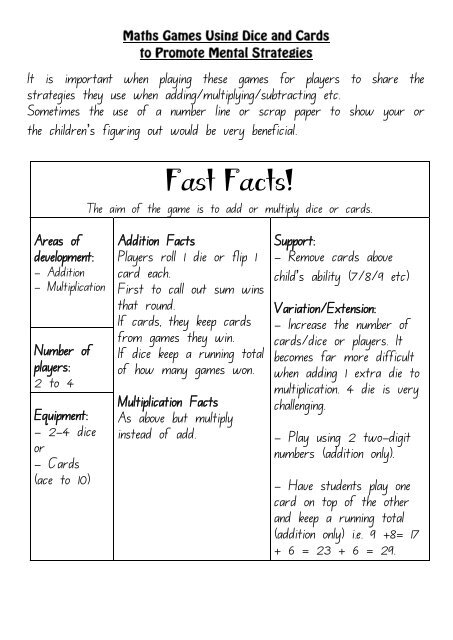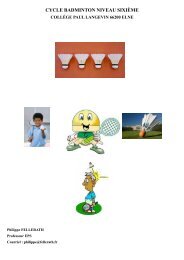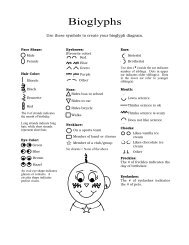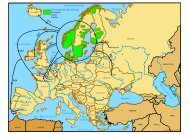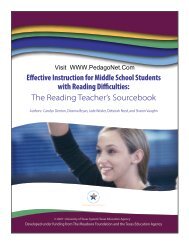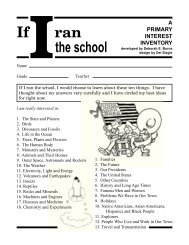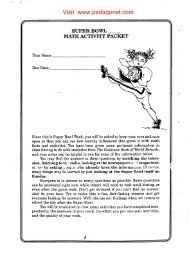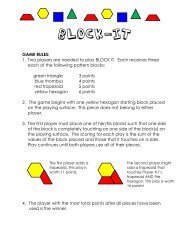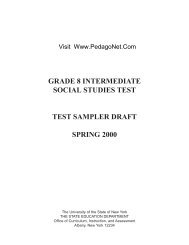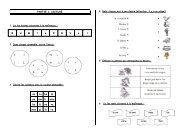Maths Games Using Dice and Cards to Promote ... - PedagoNet
Maths Games Using Dice and Cards to Promote ... - PedagoNet
Maths Games Using Dice and Cards to Promote ... - PedagoNet
You also want an ePaper? Increase the reach of your titles
YUMPU automatically turns print PDFs into web optimized ePapers that Google loves.
It is important when playing these games for players <strong>to</strong> share thestrategies they use when adding/multiplying/subtracting etc.Sometimes the use of a number line or scrap paper <strong>to</strong> show your orthe children‟s figuring out would be very beneficial.Fast Facts!The aim of the game is <strong>to</strong> add or multiply dice or cards.Areas ofdevelopment:- Addition- MultiplicationNumber ofplayers:2 <strong>to</strong> 4Equipment:- 2-4 diceor- <strong>Cards</strong>(ace <strong>to</strong> 10)Addition FactsPlayers roll 1 die or flip 1card each.First <strong>to</strong> call out sum winsthat round.If cards, they keep cardsfrom games they win.If dice keep a running <strong>to</strong>talof how many games won.Multiplication FactsAs above but multiplyinstead of add.Support:- Remove cards abovechild‟s ability (7/8/9 etc)Variation/Extension:- Increase the number ofcards/dice or players. Itbecomes far more difficultwhen adding 1 extra die <strong>to</strong>multiplication. 4 die is verychallenging.- Play using 2 two-digitnumbers (addition only).- Have students play onecard on <strong>to</strong>p of the other<strong>and</strong> keep a running <strong>to</strong>tal(addition only) i.e. 9 +8= 17+ 6 = 23 + 6 = 29.
Make 10/20/100 (or higher)The aim of the game is <strong>to</strong> make 10 (or a higher chosen number) usingcombinations of cards. Player with the most cards in combinations atthe end of game is the winner.Areas ofdevelopment:- Addition-MultiplicationNumber ofplayers:2 <strong>to</strong> 4Equipment:- <strong>Cards</strong>(ace <strong>to</strong> 10)Make 10Lay out ten cards faceup.Take turns removingcombinations (two ormore cards) that add <strong>to</strong>a <strong>to</strong>tal of ten.Replace cards when takenfrom middle pile.Continue until no cardsleft in pile.Make 20As above but aim forcombinations <strong>to</strong> 20 (6 +9 + 5).Make 100 (or more)As above but also usetwo digit numbers (38 +62 = 100)Variation/Extension:- Choose a target number offthe decade (i.e. 24, )-You may introducesubtraction (3 + 9 – 2 =10), multiplication (2 x 5 + 4= 20) <strong>and</strong> division (8 4 x10 = 20)- ‘Fishing for 10/20/100’Players are dealt 7 cardseach.They try <strong>to</strong> make combinationsof target number.They then take turns askingplayers for cards <strong>to</strong> make acombination.If the other player does nothave card, they reply “fish”<strong>and</strong> player picks up card frompile.Play until one player has nocards left, they win!
Double, Halve or StayUse doubling or halving <strong>to</strong> get as close <strong>to</strong> target number as possible.Areas ofdevelopment:-Multiplication- DivisionNumber ofplayers:2 <strong>to</strong> 4Equipment:- 2 diceOr- <strong>Cards</strong>(ace <strong>to</strong> 10)Double, halve or stayChoose a target number between5 <strong>and</strong> 122. Players take turns<strong>to</strong> roll the dice/flip 2 cards <strong>to</strong>make a two-digit number.The player then makes a decision<strong>to</strong> produce a number that is asclose as possible <strong>to</strong> the targetnumber.They can choose <strong>to</strong>:• double their number• halve their number• keep the number as isThe player closest <strong>to</strong> the targetis the winner.Support:-Use target numbersbetween 5 <strong>and</strong> 90 <strong>and</strong>cards 4 <strong>and</strong> belowonly.Variation/Extension:- Allow players <strong>to</strong>divide their number byany number theychoose. So if thetarget number is 20<strong>and</strong> they have 88 theymay divide this by 4<strong>to</strong> make 22.- Use higher targetnumbers <strong>and</strong> flip 3cards allowing player<strong>to</strong> arrange cards asthey choose i.e. targetnumber 430 flip 7,5<strong>and</strong> 3. Player maymake 753 <strong>and</strong> halve.Make sure you emphasise having fun while learning. See if you oryour children can figure out different rules <strong>and</strong> variations <strong>to</strong> makethe games more or less challenging or <strong>to</strong> create their own games<strong>to</strong> play.


